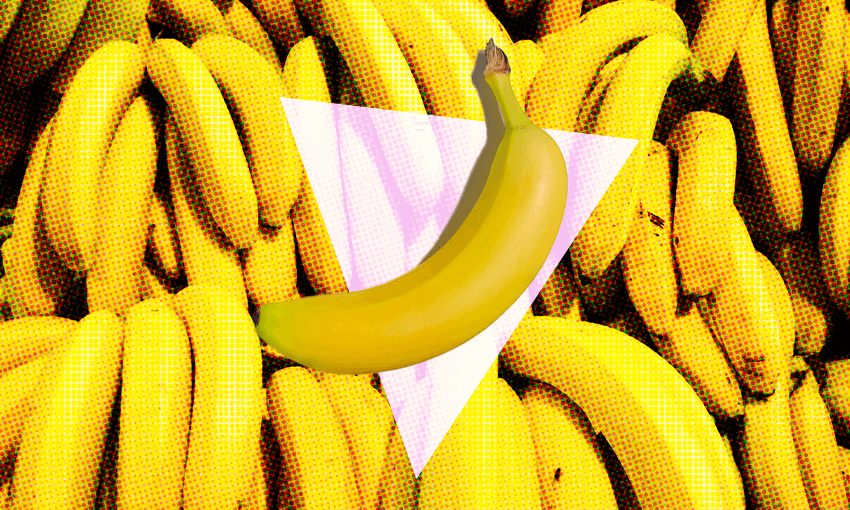The taken for-granted stalwart of the fruit bowl has plenty to offer. Simply peel to reveal their abundant potential.
It’s always banana week, really. Bananas (botanically a berry, wonderfully called “hands” when in bunches, “fingers” individually) grow year-round and in 135 countries, so they’re always in the fruit bowl. Old reliable.
But… maybe, not.
The common Cavendish banana has zero genetic diversity. Sure, you certainly know what you’re getting when you buy a banana, but the downside is high vulnerability to disease. A different breed of banana, the Gros Michel, dominated the global markets for a century before being wiped off the shelves by Panama disease during the 1950s. My dad sometimes reminisces about these Bananas of Olde; sweeter, simply more banana-y. Not that I entirely trust his account, since he was born in 1960.
Concerns that our widely loved yellow Cavendish could soon meet the same diseased fate, and that there’s no strand of banana that could adequately replace it, have led to various genetic engineering programs, desperately focused on creating a disease-resistant banana for the masses.
There are actually more than 1,000 varieties of banana and plantain grown around the world, and they’re extremely important for food security in developing countries as they produce fruit year round. But with green, red, purple and pink skins; inch-long or fused fruit; bright orange pulp; and large spiky seeds that break teeth, they’re not what you’re used to slicing over your Weet-Bix.
As well as a delicious fruit, bananas are also used to make fibre for materials, banana wine, and banana beer, which all sound incredibly intriguing. You can read about banana sustainability and worker exploitation here, but in short, it’s best to get Rainforest Alliance and Fairtrade certified ‘nanas when you can, because the yellow fruit are big drivers of deforestation and poor labour conditions.
Where to find bananas
Welcome to your in-miniature grocery price comparison for the week. At Countdown, bananas (from Mexico or Ecuador, and Rainforest Alliance-stamped) are $3.70/kg, just under a dollar each. At New World you’re paying 9c more per kg for Ecuadorian bananas, or go to Pak’nSave for $3/kg – although for both Foodstuffs brands, Rainforest Alliance isn’t indicated.
Supie has the biggest range of banana options. For Ecuadorian bananas, Supie’s prices are just below Pak’nSave at $2.95/kg or two bananas for $1.60. For Fairtrade or organic, you’re looking at $4.75 for a bunch. The winner, however, if you’re a banana smoothie or baking fan, is buying a browned, frozen bunch of Supie bananas for just 15 cents.
How to make bananas terrible
Look, it turns out that I have a lot to say here. For me, a person with a delicate gag reflex, the answer is simple: eat a banana on its lonesome. Hey presto, gagging. The sliminess of a chewed-up banana just sets me off. That being said, for about a year in my early twenties I’d gag every time I brushed my teeth… so maybe it’s just me.
Then there are frozen bananas. A lot has been said here; “One ingredient vegan ice cream!” or, “like a delicious ice cube to put in your smoothie!” etc. While a blitzed frozen banana does make a surprisingly delicious ice cream, it only remains delicious for about 50 seconds. After that, your banana has defrosted to gloop, and all you have left is slime – so eat fast.
There are also significant pitfalls to freezing bananas, and my mum is Head Perpetrator. When a banana gets a touch overripe, my mum places it whole and unpeeled into the freezer, where it joins a colony of about 30 of its frost-bitten, skin-blackened brethren. If you’re brave enough to partake in one of these frozen and wrinkled souls, you have to slice away the ice-cold skin with a sharp knife while your own skin melds painfully to the banana, or else wait until you have an old, damp banana skin full of melted gloop.
Note (this is for you, Mum): to properly freeze a banana, peel it, break it into bite-sized chunks, put it in a container or snaplock bag, and eat it within 2 weeks.
How to make bananas amazing
I can’t tell you much you don’t already know here. Banana splits are an amazing dessert, especially when you make your own chocolate sauce and top it off with chopped roasted peanuts.
For light, gluten-free pancakes, just mash up a banana, mix in half a teaspoon of baking soda and a sprinkle of cinnamon, stir through a beaten egg or two, then fry in butter. Tasty and quick, although “pancakes” is perhaps an exaggeration – more like pikelets, because if you can’t fit the entire thing on your spatula, it will absolutely break in half during flipping.
A great snack or “I-forgot-lunch” lunch is toasted Vogel’s with peanut butter and sliced banana. If I’m feeling indulgent, I’ll add a drizzle of honey, a pinch of sesame seeds, a small sprinkling of ground cinnamon – toast dynamite.
Another winner: slicing a banana in half lengthways and frying it in plenty of butter until caramelised and gooey. The perfect pancake or French toast topping, and a great little dessert on its own if you need a quick sugar hit.
And, of course, you can’t go past a really good banana loaf or muffin, for which you need those nearly rotting-looking bananas for best results. This recipe for banana and chocolate chunk muffins has never failed me, and I’d strongly recommend using two thirds dark chocolate, one third caramelised white chocolate (e.g. Whittaker’s Blondie). They’ll disappear in no time.
Wyoming Paul is the co-founder of Grossr, and runs a weekly meal plan that connects to online supermarket shopping.

